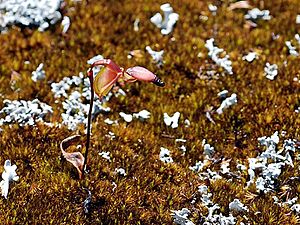Granite duck orchid facts for kids
Quick facts for kids Granite duck orchid |
|
|---|---|
 |
|
| Conservation status | |
| Scientific classification | |
| Synonyms | |
|
The Caleana granitica, also known as the granite duck orchid, is a special type of orchid. It grows only in the south-west part of Western Australia. This means it is endemic to that area.
This unique orchid has a single smooth leaf. It also grows a single flower that is greenish-yellow and red. The flower's special lip, called the labellum, points downwards. You can find this orchid growing on just one granite rock area near Armadale.
Contents
What Does the Granite Duck Orchid Look Like?
The granite duck orchid has one smooth leaf. This leaf can be dull green or dull red. It is usually about 10 to 20 millimeters (0.4 to 0.8 inches) long. The leaf is also about 2 to 4 millimeters (0.08 to 0.16 inches) wide. Often, the leaf has dried up by the time the flower blooms.
Usually, only one flower grows on each plant. The flower is greenish-yellow and red. It is about 20 to 25 millimeters (0.8 to 1.0 inches) long. It is also about 10 to 12 millimeters (0.4 to 0.5 inches) wide. This flower sits on a stem that is about 40 to 70 millimeters (1.6 to 2.8 inches) tall.
The top part of the flower, called the dorsal sepal, is narrow. The side parts, called lateral sepals, and the petals also hang down. The dorsal sepal presses against a part of the flower called the column. This column has wide parts that make a shape like a small bucket.
The labellum (the orchid's lip) has a flat top. It points downwards, below the middle of the flower. About one-half to one-third of its outer part is covered with shiny black bumps. These bumps are called glands or calli. The granite duck orchid flowers from October to early December.
How the Granite Duck Orchid Got Its Name
Scientists first officially described the granite duck orchid in 2006. Stephen Hopper and Andrew Brown gave it the name Paracaleana granitica. They published their description in a science journal called Australian Systematic Botany.
Later, in 2014, other scientists studied the orchid's genes. Based on their findings, Joseph Miller and Mark Clements moved all species from Paracaleana into the Caleana group. This is why the orchid is now called Caleana granitica.
The second part of its name, granitica, tells us something important. It refers to the granite rock where this special orchid grows.
Where the Granite Duck Orchid Lives
The Caleana granitica grows in a specific place. It lives among mosses and lichens on a granite rock area. This spot is located south of Armadale. It is part of a larger natural area called the Jarrah Forest biogeographic region.
Protecting the Granite Duck Orchid
The Government of Western Australia's Department of Parks and Wildlife has a special list. On this list, Caleana granitica is called "Priority One".
Being "Priority One" means this orchid is very rare. It is known to grow in only one or a few places. These locations could be at risk, so it's very important to protect them. This helps make sure the granite duck orchid can continue to grow and thrive.


